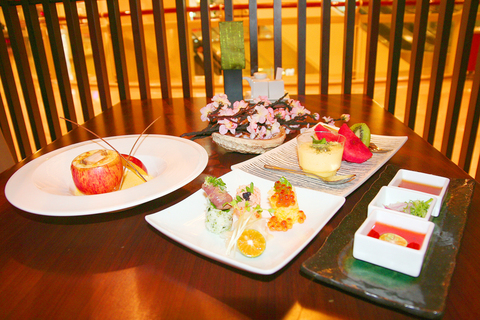Impeccably dressed in a formal suit and silk tie the manager of Wasabi, Ken Chen (陳偉德), placed a live abalone and tiger shrimp on a dish piled with steaming stones, then added sake. There was a whoosh and the air became scented with alcohol, herbs and seafood.
Other diners looked around, surprised by the sound or fragrance, and watched as Chen discreetly covered the plate with a lid that had a small hole in it, allowing a jet of steam to escape. We were told this was done so no-one had to witness the death throes of our tasty mollusk and crustacean.
It doesn't get much more natural or fresher when the catch-of-the-day is live abalone from waters near the South Pole.

PHOTO: JULES QUARTLY, TAIPEI TIMES
“Abalone is the king of seafood,” said the executive chef of Wasabi, Yankee Yang (楊正全). “These shellfish are from the least polluted seas in the world, off the Tasmanian coast by the South Pole. This live performance is a traditional and creative way of cooking. You really can taste the sea.”
The “Live Australian Abalone Set Menu” is a seven-course meal of fusion fare crafted by Yang, who learned the arts of preparing sashimi and sushi in Japan.
The meal began with abalone salad, which was served with green asparagus and bamboo shoots. The bream soup was artfully prepared as the fish was given a thin covering of flour before being steamed, so it retained its full flavor and moisture.
As may have been expected the quartet of sashimi slices — abalone, octopus, fish and shrimp — were excellent, partly because they came with wasabi made that day, grated from the root rather than recombined from powder. The sushi platter offered four taste explosions, notably the foie gras, which was outstanding.
The only dish your reviewer had reservations about was the grilled and buttered abalone in apple. The various fish elements were overpowered by a fruity, creamy, almost cheesy taste. Asian palates, we were told, are tickled by this combination but it left us unmoved.
Over 1 million Japanese visitors a year pour into Taiwan because it's relatively close, has the tallest building in the world and has many of the trappings of home: namely good shopping, hot springs and fresh fish prepared in a Japanese style.
Wasabi in the Taipei 101 Mall, therefore, is a popular destination for these tourists. So, unless you want to wait for a table and perhaps be disappointed, booking is advised.

As I finally slid into the warm embrace of the hot, clifftop pool, it was a serene moment of reflection. The sound of the river reflected off the cave walls, the white of our camping lights reflected off the dark, shimmering surface of the water, and I reflected on how fortunate I was to be here. After all, the beautiful walk through narrow canyons that had brought us here had been inaccessible for five years — and will be again soon. The day had started at the Huisun Forest Area (惠蓀林場), at the end of Nantou County Route 80, north and east

Specialty sandwiches loaded with the contents of an entire charcuterie board, overflowing with sauces, creams and all manner of creative add-ons, is perhaps one of the biggest global food trends of this year. From London to New York, lines form down the block for mortadella, burrata, pistachio and more stuffed between slices of fresh sourdough, rye or focaccia. To try the trend in Taipei, Munchies Mafia is for sure the spot — could this be the best sandwich in town? Carlos from Spain and Sergio from Mexico opened this spot just seven months ago. The two met working in the

Exceptions to the rule are sometimes revealing. For a brief few years, there was an emerging ideological split between the Democratic Progressive Party (DPP) and Chinese Nationalist Party (KMT) that appeared to be pushing the DPP in a direction that would be considered more liberal, and the KMT more conservative. In the previous column, “The KMT-DPP’s bureaucrat-led developmental state” (Dec. 11, page 12), we examined how Taiwan’s democratic system developed, and how both the two main parties largely accepted a similar consensus on how Taiwan should be run domestically and did not split along the left-right lines more familiar in

A six-episode, behind-the-scenes Disney+ docuseries about Taylor Swift’s Eras Tour and Rian Johnson’s third Knives Out movie, Wake Up Dead Man, are some of the new television, films, music and games headed to a device near you. Also among the streaming offerings worth your time this week: Chip and Joanna Gaines take on a big job revamping a small home in the mountains of Colorado, video gamers can skateboard through hell in Sam Eng’s Skate Story and Rob Reiner gets the band back together for Spinal Tap II: The End Continues. MOVIES ■ Rian Johnson’s third Knives Out movie, Wake Up Dead Man